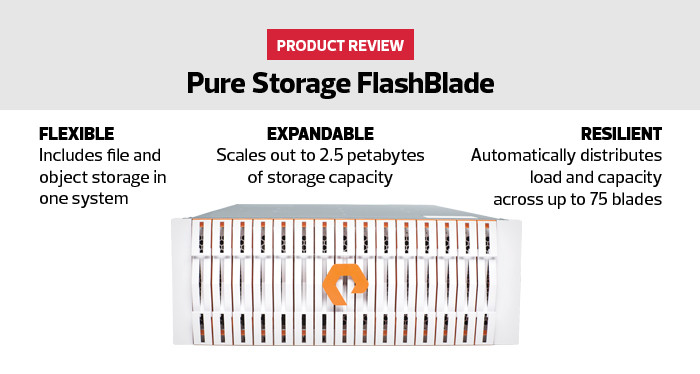The FlashBlade system is fast enough (at about 1 gigabyte per second, per blade, or up to 75GBps with 75 blades) to support — with one set of five chassis — thousands of systems for virtual desktops as well as data lakes, Big Data and high-performance computing. As the federal government becomes more focused on data and other high-value assets, such robust performance will be critical for adequate storage.
The system also supports standard storage protocols (including NFS, SMB and HTTP) as well as block-level devices, with built-in thin provisioning, compression, snapshots, and encryption and data locking. Each of these deliver exceptional speed and reliability.
Variable block sizes make it possible to eliminate, say, a 4K block with only a few bytes of data. Instead, users can tailor block sizes to fit file sizes, saving all the zeros at the end of a block.
With speed, power and an extensive feature set, the FlashBlade system is capable of meeting the requirements for a wide range of important federal IT tasks, from providing virtual machines to supporting data-intensive research.
MORE FROM FEDTECH: What is an electronic document management system and why do you need one?
Support for Redundancy and Rapid Reconstruction
Pure Storage engineered the FlashBlade system for flash and NVMe flash. Many older systems have a long history of data center use, but this is a mixed blessing. Those systems also have a long legacy of old protocols that are based on hard-disk standards, which means that old commands and methods of accessing data (dating back to the 1960s) are included in many modern standards for addressing storage.
This adds overhead to modern devices that operate more like RAM than traditional rotating storage in how they’re accessed. Pure Storage bypasses those old protocols and standards with an all-flash system.
To ensure redundancy and fault tolerance, the FlashBlade system uses erasure coding as well as variable block sizes, distributing files across multiple blades in multiple chassis, with sufficient error correction so that even if any pieces are lost, the whole file can be quickly reconstructed.
In addition, pulling files from multiple locations on multiple blades increases throughput. With the FlashBlade, that happens automatically — no need for planning on the part of the administrator. The system is elastic and dynamic, self-optimizing for maximum throughput on files that see the most use, without sacrificing performance on other files.
Pure Storage FlashBlade
Processors: 8-core Xeon, per blade
Connectivity: 8x40Gbps Ethernet or 32x10Gbps Ethernet connectors per chassis
Power: Four redundant power supplies in N+2 configuration
Chassis: 4U, holds up to 15 blades
Custom Configurations: REST APIs










